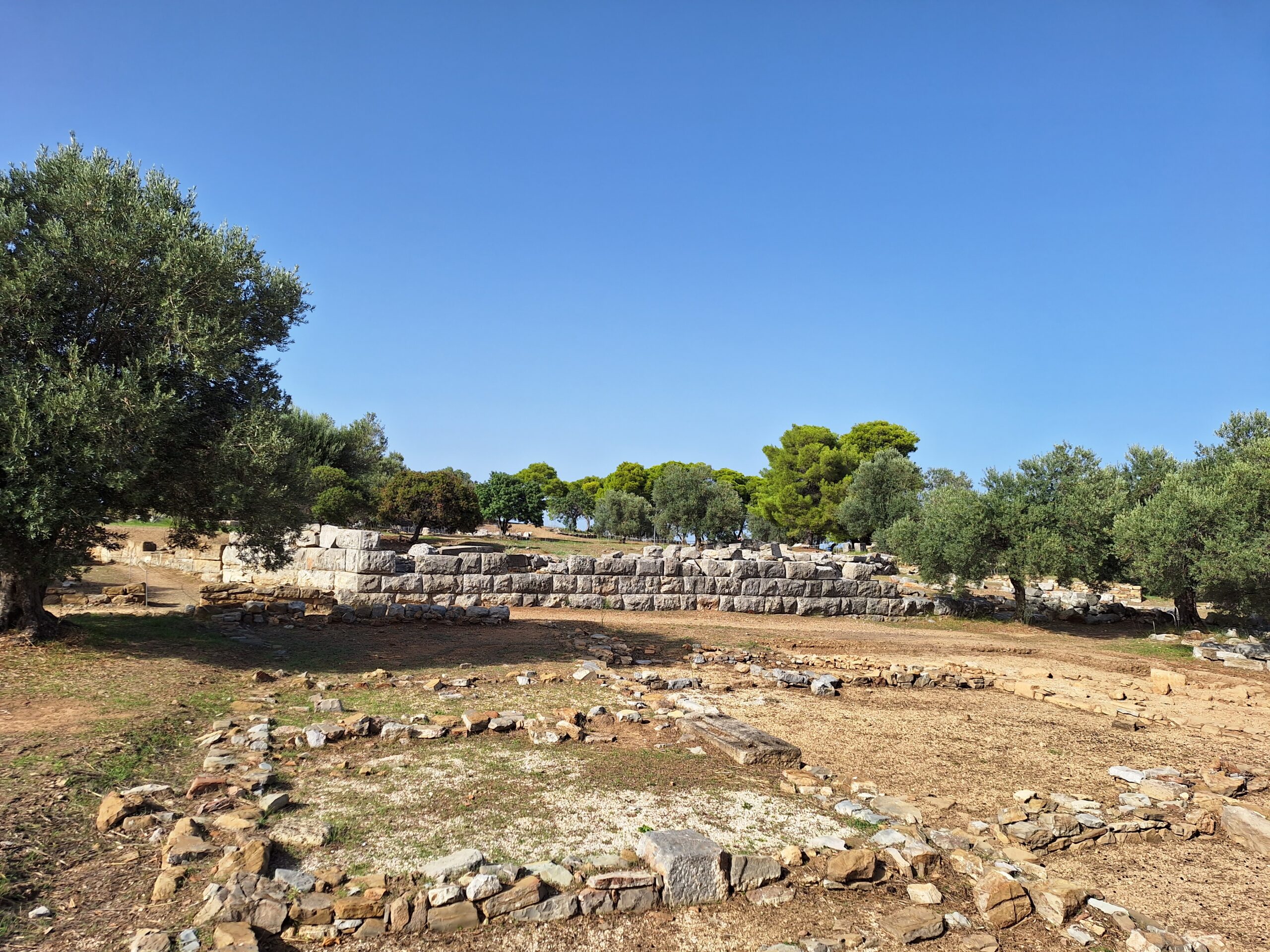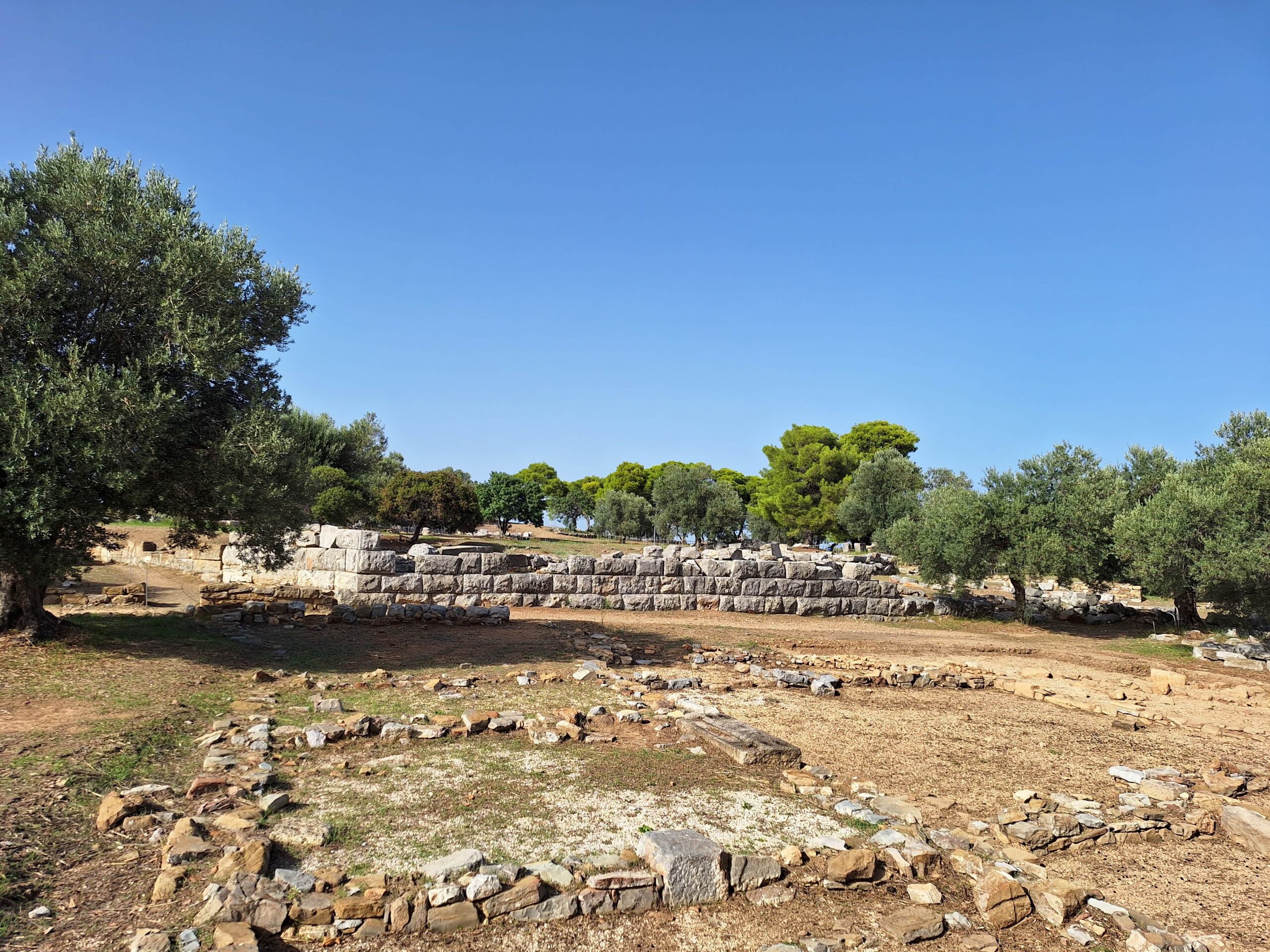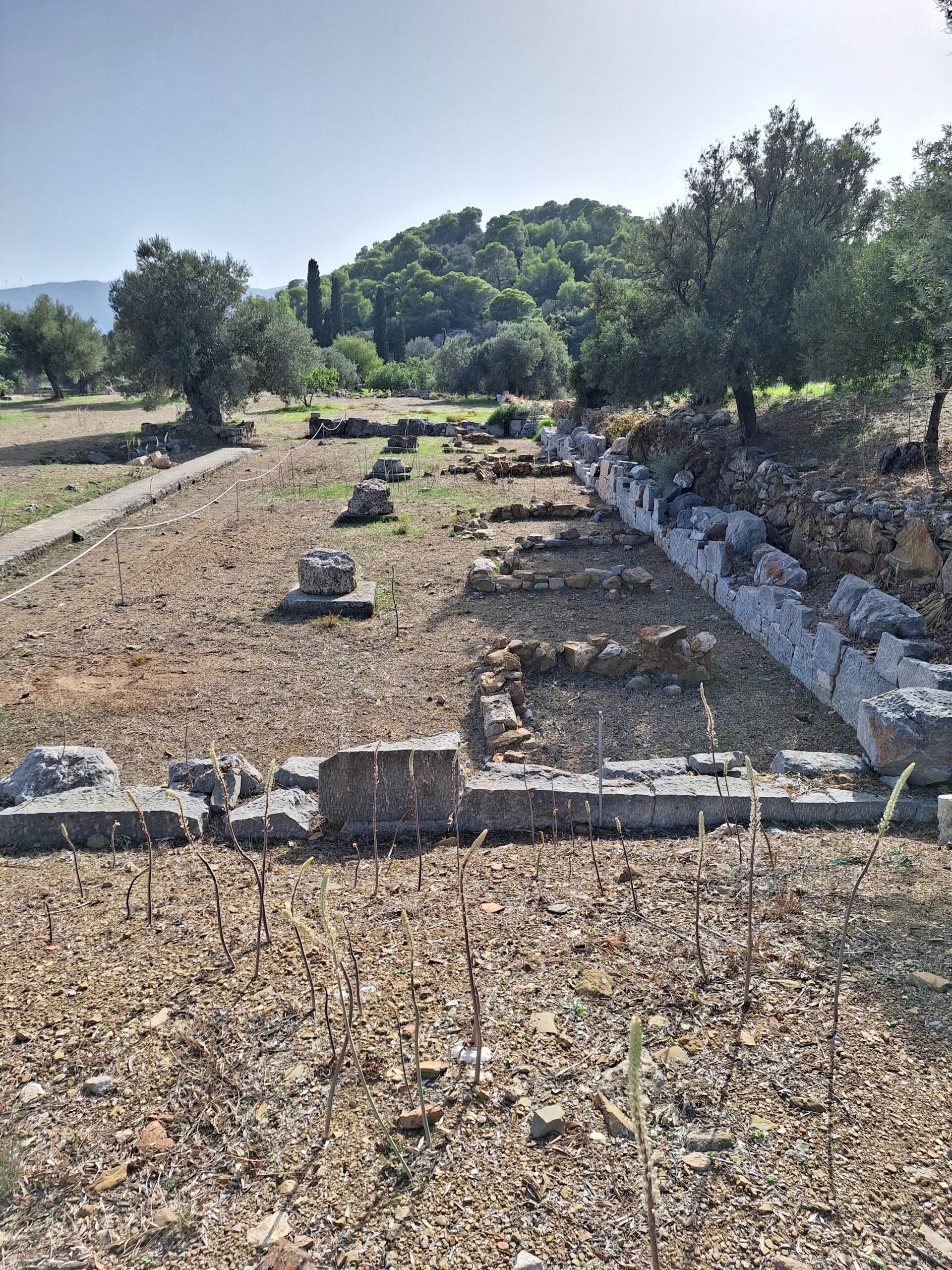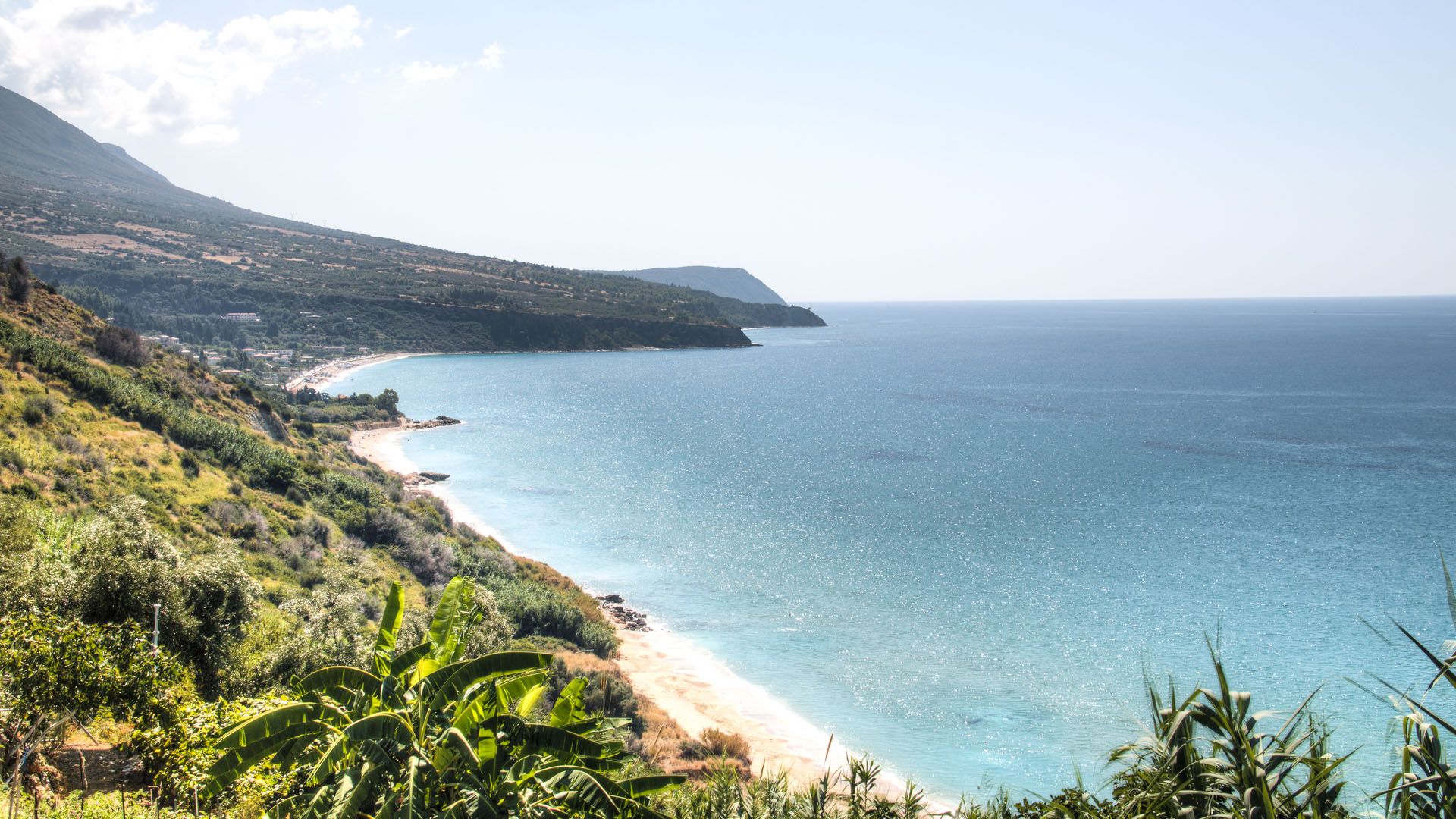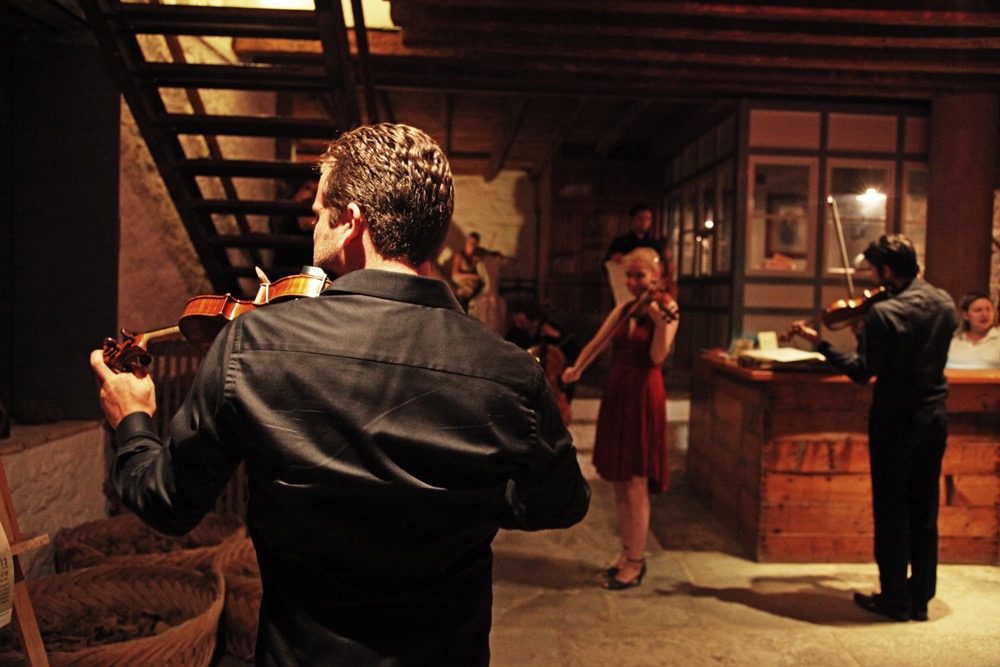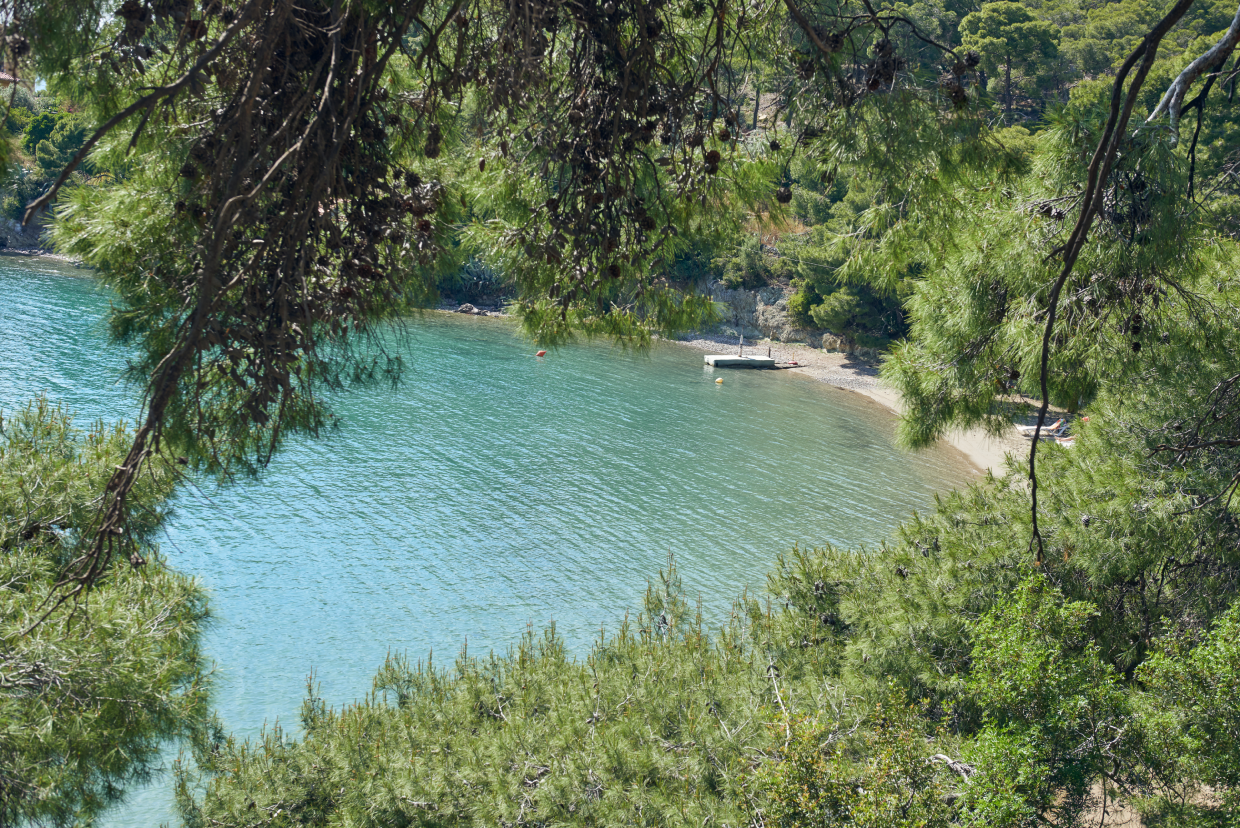Sanctuary of Poseidon in Kalavria Poros
Sanctuary of Poseidon in Kalavria Poros
After Gefyraki, if you continue to the left, in Synoikismos, and follow the winding road between large pine trees, there is the Temple of Poseidon in Poros. Today there are only a few remains of the 6th century blue limestone Doric temple. It is located between Vigla and Prophetis Elias.
The Temple of Poseidon was built around 520 B.C. It had dimensions of 14.40 x 27.40 m with a facade facing north-east and was a Doric pavilion with 6 columns on the short sides and 12 columns on the long sides. The temple was located inside a rectangular enclosure measuring 52.95 x 26.05 m. with 2 entrances, one on the north-eastern side, directly opposite the entrance to the temple, and a second on the south-eastern side, in the middle of the corresponding side of the temple. As for the Classical period, the only additional element we know of is the construction of a wider mosque to the south-east of the old one and an extension to the south-west.
On the north-west side of this extension was built, around 420 B.C, a portico facing south-east. It had dimensions of 9, 30 x 30.20 m., probably 9 Doric columns in front and 4 Ionic columns in the central long axis. After 50 years, it was built to the southwest of the previous portico, and in its extension, another one with the same orientation, of which few remains were saved. It had dimensions 30.50 x 9.45 m. and 5 internal columns. After another 20 years, the other portico was built opposite, with the facade to the northwest (dimensions 29.65 x 7.40 m.). About ten years after the propylon, around 320 BC, another one (32.80 x 3.95 m.) with a Doric colonnade on the facade was built in the extension of the third stoa. To the southwest of the Temple, there was a building with dimensions of 31 x 11 m. which may had been the Bouleuterion of the city of Kalavria. It was the meeting place of the representatives of the seven cities participating in the Amphictyony of Kalavria. To the south-west of the Bouleuterion, there was another building (the Monument of Demosthenes or the Asklepion).
The Temple of Poseidon was a famous sanctuary that took in the persecuted. The orator Demosthenes was the most famous person to seek refuge here when he was pursued by the Macedonians who had occupied Athens. He drank poison there and was buried in the sanctuary. The sanctuary of Poseidon in Poros is one of the most important monuments of antiquity, with great importance for Poros today. The excavations that have been carried out to date have already unearthed many impressive finds. Findings that may even change what we know about religious life in ancient Greece. Each new period of excavation brings new information, new clues about the ancient inhabitants of the island and the surrounding area, some of which are presented here. Judging by the frequency with which new discoveries are made, the Sanctuary of Poseidon still holds many surprises for archaeologists and the people of Poros.
In the area of the sanctuary of Poseidon there was not only the temple of Poseidon, well known in classical antiquity, but also a whole complex of auxiliary and other buildings which surrounded it. In fact, these buildings are better preserved today than the temple itself, which has not survived, and they provide valuable information about the way the ancient inhabitants of Poros and visitors lived and worshipped. Thus, when we speak of the “Sanctuary of Poseidon”, we are actually referring to all these buildings, which form a unit and have been uncovered over a large area thanks to the efforts of the archaeological team. The first archaeologists who worked on the sanctuary of Poseidon in Poros at the end of the 19th century were two Swedes, Samuel Wiede and Lennart Kjellberg. The former was a personal friend of great archaeologists such as Schliemann and Dorpfeld. Dorpfeld was excavating in ancient Olympia at the time and encouraged Wiede to excavate in Poros, where, according to Pausanias, there was the temple of Poseidon, where the famous orator Demosthenes, pursued by the Macedonians, had taken refuge and eventually committed suicide. Samuel Vide came to Poros in 1894, bringing with him some skilled workers from the German excavations at Olympia. He rented some stone houses, which still stand in the area, to house the local and foreign workers who worked with him. In fact, this small settlement was named after him and is still known as “Samuel”. Vide’s excavations in 1894 showed that there were extensive facilities in the area. It is not known why the Swedes did not continue at that time. Perhaps it was the lack of impressive finds like those at Olympia. It could also have been because of a lack of money. But the first step had been made. Excavations began again in 1997. The first excavation period, from 1997 to 2005, was slow due to a lack of resources. However, the work that was done was important. First of all, the area was cleaned and shaped. The environment of the sanctuary as it is today was created during these years, and it is certainly not as the older people remember it.
At the same time, the points of greatest archaeological interest were identified and the first test excavations began. It soon became clear that this was not a single temple, but an entire cult complex, with many ancillary buildings, arcades, a parliament, and even a town that developed around it. This was in line with the ancient sources, which described the sanctuary as the seat of an important amphictyony, i.e. a religious confederation of cities. The new phase of the programme, which is still ongoing at the time of writing, began in 2007. With new funding from the National Bank of Sweden, a team of experts of various nationalities was established and is still working on the sanctuary.
FINDINGS TODAY
The sanctuary of Poseidon is not rich in impressive monuments, as we are perhaps used to seeing in other important sanctuaries in Greece. The temple itself, as well as the rest of the buildings, were moved to Vagionia, from where they were transported by ship to Hydra, probably to build the monastery there. It is known for certain because an eye-witness, the English traveller Richard Chandler, who was in Poros at the end of the 18th century, described it. Certainly, some of the stones of the sanctuary have been taken to the interior of the island in recent years, perhaps for the construction of the monastery of Zoodochos Pigi, but also for private buildings, as some of the findings of the new excavations have shown. The habit of using parts of ancient buildings to build newer ones is something that we find very often all over Greece, not only in modern times, but also in ancient times. Nevertheless, it is wrong for the people and friends of Poros to believe that there is “nothing” in the sanctuary of Poseidon. The findings may not be impressive, but they are certainly very interesting and very important. From an architectural point of view, the new round of excavations has studied and highlighted a number of buildings that are visible to the visitor. The excavations have also brought to the surface structural elements that give us a better idea of the site and its inhabitants. During this year’s excavations, a perfectly preserved inscription came to light, a gift from the city of Arsinoe – now the Paleokastro of Methana – to Poseidon. This inscription was the basis for two statues, Queen Arsinoe and King Ptolemy, which have not yet been found. In fact, the inscription was not found where it was originally placed, but was probably abandoned where it came to light, by someone who took it to the interior of the island as building material. Near this inscription, pieces of a much older structure were found. They are large, round “vertebrae”, as archaeologists call them. The pieces of a column, if it had ever stood upright, would probably have been six metres high. It was probably a votive column, another offering to the god Poseidon. However, this column was never erected, because the sides of the columns are not finished. On the one hand, this confirms the conclusions of the archaeologists that the sanctuary of Poseidon experienced a period of great unrest around 500 BC. On the other hand, it also offers us a very rare element: engraved on the surface of the columns are the ancient builder’s notes to himself. He had left some symbols to help him remember in which order to place them.
In addition to these impressive discoveries, unprecedented facts about the daily life and worship of the inhabitants of ancient Poros have come to light. The excavations have brought to light a large number of small objects: hooks, net weights, plates and vases, spearheads, etc. All this is slowly but surely building up a picture of life on the island, the diet, the habits of the inhabitants and their visitors. For example, we now know for certain that a very large meal was held at the sanctuary sometime in 165 BC. It is estimated that around one hundred and fifty people took part in this meal, eating a variety of meat, fish, birds, eggs and seafood. This variety suggests that these foods were brought to Poros from other places, perhaps by the participants themselves. The remains of this meal were discovered buried and covered with stones and earth in a corner of the sanctuary. Near this place there was an ancient cistern, which reached a considerable depth. When this cistern was opened during the 2004-2005 excavation period, some of the strangest finds ever made were unearthed: Dog bones with knife and fire marks, indicating that they had been butchered, cooked and probably eaten. Snake bones that suffered the same fate. Also limbs of horses and other animals, puppies, fish, birds, eggs, frogs and porphyry. Perhaps these are the remains of a ceremony that is unique and unrepeatable, both in written testimony and in other excavations throughout the Greek area.
At the same time, new technologies make it possible to create three-dimensional representations of the buildings as they were in the past, based on the architectural elements present in the space. Fictional representation has already given us the image of the so-called “Building D”, which includes the impressive wall that we see in front of us when we enter the archaeological site. But this is just the beginning. Thanks to an accidental discovery made during the excavation season, it has been possible to create a digital representation of the Temple of Poseidon itself, as it was in ancient times. It is the first accurate representation based on architectural elements and for the first time the inhabitants of Poros will be able to see, even as a model, what the ancient inhabitants of the island saw when they approached the sanctuary of Poseidon.
The site is open 24 hours a day, winter and summer. Entry is free for everyone. The site of the Sanctuary of Poseidon, in addition to being an important archaeological site, is also a public space chosen by the locals for their walks and recreation.


